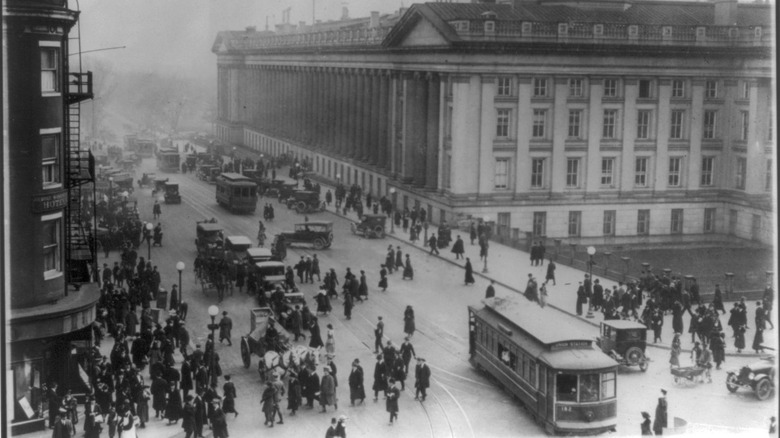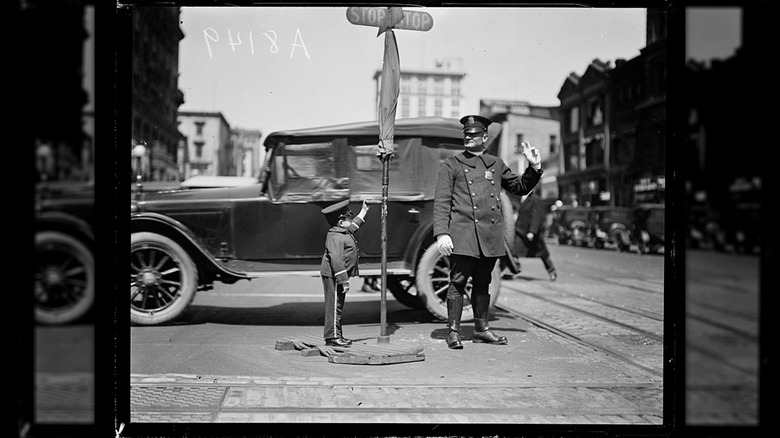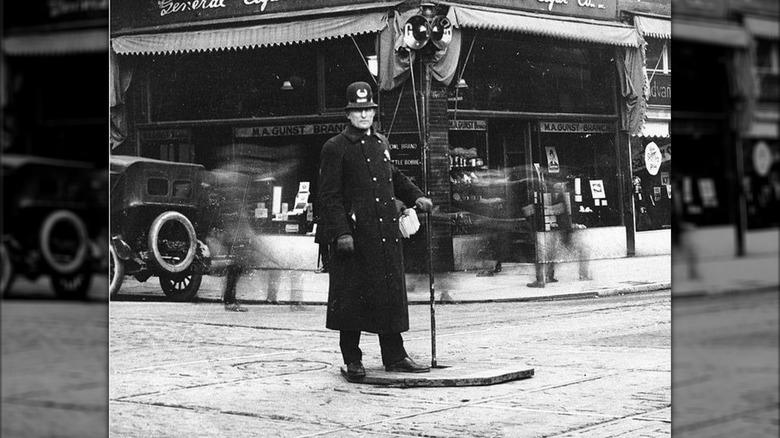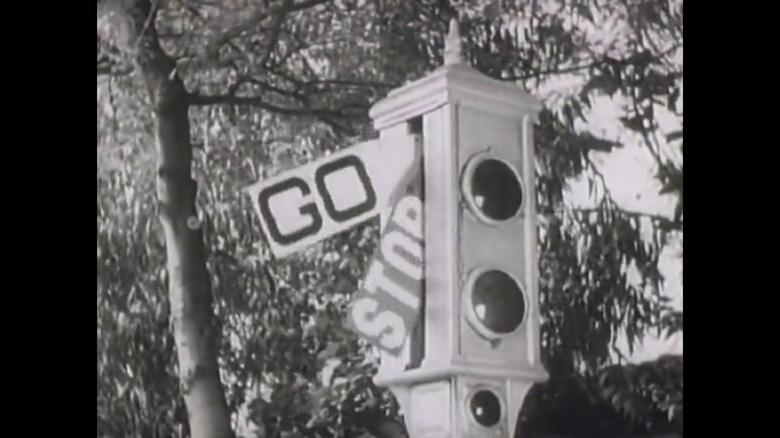The Ingenious Way Traffic Lights Worked Before Computers Were Invented
Today's traffic lights can be controlled by anything from standard traffic control computers to highly advanced AI-driven computer systems that are so "smart" they can predict what's going to happen and adjust in real time. But how did these sometimes fury-inducing congestion controllers function before the rise of computers? Let's start at the beginning.
The first gasoline-powered 3/4-horsepower automobile rolled down the streets of Manheim, Germany, in 1886. The first traffic lights, however, were being used nearly 20 years before at the intersection of Bridge Street and Great George Street near the Westminster Bridge in London, England. The year was 1868, and hundreds of thousands of carriages pulled by real horses roamed the highly snarled streets. It took 80-plus years before the first computerized signals went online in the 1950s (either in Toronto, Canada, or Denver, Colorado, depending on who you ask).
Those first London traffic lights were created by railway engineer J.P. Knight, who borrowed the same basic concept from the train industry. Each light was manually operated by a lone policeman. During daylight hours, they'd raise and lower arms sitting atop 22-foot poles that told drivers they could keep moving or stop and yield to oncoming traffic. When it was dark, flames fed by natural gas lit up colored glass — green to move, red to stop — for all to see. As it turned out, early gas-fed lines were notoriously dangerous, and the whole thing could (and did) explode spectacularly, subsequently harming any officer standing at the base of the pole, so changes had to be made.
Red light, green light
Despite the setbacks with Knight's initial concept, his brilliant idea began to spread. Soon, many interpretations were appearing in larger cities plagued by traffic congestion, most using some blend of words and/or colors and requiring manual control by an officer standing in the open all day (and night). That all changed at the dawn of the 20th century with the proliferation of electricity.
In 1910, American engineer Ernest E. Sirrine obtained a patent for a "Street Traffic System." It, too, was based on Knight's system, but this new system removed the need for human intervention. Each pole was equipped with cross-mounted arms made of glass; one displayed the word "Stop," while the other had "Proceed." They were lit by electricity and designed to rotate thanks to a motor buried in the ground directly beneath the pole. Signs along the same route were wired to work in unison and managed to control traffic flow effectively.
Two years later (1912), Lester Farnsworth Wire, a police officer in Salt Lake City, Utah, built a wooden box fitted with red and green painted light bulbs. It was mounted to a 10-foot pole, and the whole contraption was attached to nearby trolley car cables to supply power. The push-button control, which still had to be manually triggered, was located in an enclosed booth and protected officers from inclement weather. Wire never patented the idea, but it became the model for numerous future systems. Over the next handful of years, the evolution of traffic signals accelerated exponentially, primarily driven by Americans.
Electricity brings traffic signals alive
In 1914, an inventor in Cleveland, Ohio, named James Hoge created a far more advanced version of Wire's designs that was hailed as the "world's first electric traffic signal." It was installed at an intersection in Cleveland, Ohio (105th and Euclid Avenue) on August 5, 1914. Unlike Wire, Hoge actually applied for a patent in 1913, becoming the first person to do so, but didn't receive it until 1918.
These "interlocking high reflector signals" consisted of 15-foot poles at each corner of an intersection. At the top were cross arms that read "Stop" and "Move," along with now-customary red and green lights. A police officer sat in an elevated booth on the sidewalk above the throngs of pedestrians, allowing him to see in every direction. It was equipped with heat and was wired directly to local police and fire departments, so in an emergency, the officer could manually clear traffic, allowing first responders to reach their destinations faster. As people or vehicles approached the intersection, the officer either activated the flashing red "stop" light to halt traffic or the green light to "move" them along. Additionally, bells rang in accordance with the signage — one long ring was for traffic flowing along E. 105th St., while two were for Euclid Ave. travelers. Confusing to be sure, a feeling drivers still encounter even today.
In 1917, Salt Lake City became the site of the first integrated traffic signal system, with six intersections wired together and controlled at the same time. But this too was controlled manually.
Timing is everything
In 1920, police officer William Potts created the first automatic four-way system for Detroit, Michigan, by wiring all the lights at a single intersection together so they changed simultaneously. And in another first, it was also equipped with a yellow light to warn drivers a traffic signal was about to change. (Interestingly, adding another color to existing signals may be on the horizon.) Meanwhile, in Los Angeles, California, five signals installed along Broadway used a red light with the word "Stop" and a green light with the word "Go" for the first time. Like Hoge's lights, bells rang out before a signal changed.
Houston, Texas, became the first city in 1922 to install traffic light timers, finally eliminating the need for manual operation. This quickly spread, especially to big cities like New York, reducing traffic divisions from 6,000 to a few hundred. In 1923, African American inventor Garrett Morgan of Cleveland, Ohio, patented an automated three-way traffic signal shaped like a "T" that added an all-directional stop to the intersection and immediately reduced collisions. General Electric was so impressed, they reportedly paid $40,000 for Morgan's creation.
By the end of the 1920s, traffic systems had incorporated other kinds of sensors, which eventually led to the installation of pressure plates in the 1950s. When connected to new-fangled computers of the era, the system could tell when vehicles were stopped at the intersection and trigger lights accordingly, a drastic improvement over antiquated preset timers. Computers enabled precise data collection, which in turn improved traffic flow patterns and have led to today's "smart" and fully automated traffic systems.



